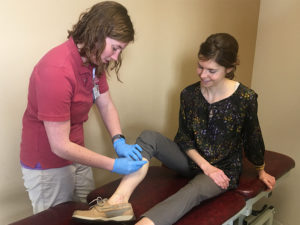
Ease trigger point pain and improve range of motion with dry needling therapy
People experiencing pain or range of motion impairment may find relief with dry needling therapy.
Dry needling is a treatment involving the insertion of a thin, dry needle through the skin into areas of the muscle to stimulate trigger points that are causing pain or affecting movement.
The treatment became available in Illinois for physical therapists to provide after Gov. Bruce Rauner signed legislation in August 2017 amending the Illinois Physical Therapy Act to include dry needling within the scope of practice for licensed physical therapists. Additional education and training and continuing education is required to perform dry needling.
Rachel Corrigan, a physical therapist and board-certified orthopedic clinical specialist with OSF HealthCare Saint James – John W. Albrecht Medical Center in Pontiac, learned about the technique during her residency.
“I was interested to know more about it,” she said. “I took the opportunity that was given to us to take the course to further enhance my skill set to be able to provide my patients with a variety of options to treat their pain or range of motion deficits.”
Sometimes, Corrigan said, there are times in patient care where progress comes to a halt. “I have found this to be another good option if another less invasive treatment is not helping.”
Based in Western medicine
Other terms commonly used to describe dry needling include trigger point dry needling and intramuscular manual therapy. Dry needling is not to be confused with acupuncture, a practiced based on traditional Chinese medicine. Dry needling is rooted in Western medicine principles and is another tool therapists have to provide manual therapy. Research on its use and effectiveness continues, Corrigan said.
Why use dry needling?
 This technique typically is just one aspect of a patient’s treatment, Corrigan said. The goal is to release the trigger point to relieve pain and improve the patient’s range of motion, allowing them to return to more active rehabilitation.
This technique typically is just one aspect of a patient’s treatment, Corrigan said. The goal is to release the trigger point to relieve pain and improve the patient’s range of motion, allowing them to return to more active rehabilitation.
“The thought behind the procedure is that the needle is pushed through the trigger point to stimulate that area. The stimulation of the needle is thought to help release the taught bands to decrease pain and increase function,” Corrigan said. “Dry needling allows therapists to target areas deeper in the muscles that we cannot always get to with the use of our hands. Dry needling can allow the therapist to also target a specific areas of pain due to the small needle size.”
Conditions best suited for dry needling
Dry needling can be performed on both upper and lower extremities, as well as the neck and lower back, Corrigan said.
“It is more patient specific as far as if it is an appropriate treatment,” she said. “If a patient has just had surgery we wait a longer period of time before using dry needling if it’s appropriate treatment for them and their physician has approved.”
As with most invasive techniques there are risks involved. For dry needling this includes soreness, minimal bleeding and risk of infection, Corrigan said.
Patient feedback
“Most feedback from patients so far has been positive,” Corrigan said. “I have seen success with my patients for both pain relief and increased motion.
“Dry needling is not for everyone, so we discuss dry needling with patients on a case-by-case basis,” she said. “There is still research being done for dry needling. We hope to know more about this technique.”
If you think you could be helped, talk with your doctor about dry needle therapy.
Contact your primary care physician for a referral or call:
OSF HealthCare Saint James Rehabilitation Services Department at (815) 842-4591
OSF HealthCare Saint Anthony’s Health Center Rehabilitative Services at (618) 463-5171.